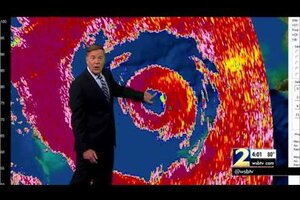Hurricane Matthew: Why are birds flying in the eye of the storm?
Hurricane Matthew: Meteorologists tracking the hurricane on radar spotted birds flying in the eye of the storm, traveling along as it moves up the US east coast.

Bright red spots in the hurricane radar show that some birds are traveling in the eye of the storm.
When birds get stuck in the strong winds of a hurricane, their strategy is often to ride it out within the eye of the hurricane, the calmest spot in the chaos.
As hurricane Matthew travels north along the US east coast, meteorologists studying the radar images spotted bright red spots in the center of the storm's swirling winds Friday, identifying them as trapped birds.
"Those are seagulls and birds that are flying inside the eye of the storm trying to escape the strongest part of the storm which is in the north and north-eastern center of it," meteorologist Glenn Burns told WSB-TV in Atlanta, as reported by USA Today.
According to the Weather Channel, birds were also spotted in September when hurricane Hermine hit Florida, and in 2014 when hurricane Arthur landed in North Carolina. Kenn Kaufman, a National Audubon Society field editor, described in a 2011 article that the birds probably got pulled into the hurricane’s “wild wind,” and when they come to the calm eye, they choose to stay until the winds die rather than fighting it again.
But most of the time, the birds migrate in the fall before the hurricanes hit to avoid running into hurricanes, although their timing may sometimes coincide with bad weather.
“Presumably a bird tends to take off when the wind is favorable, just after the passage of a low-pressure system,” Kaufman wrote. “If they take off when conditions are good, there’s a chance that they’re not going to run into a hurricane.”
Bird watchers, however, have sometimes braved the dangerous storms just to glimpse these birds who get blown out of their habitat when traveling with a hurricane. As Charles Kennedy, president of the South Alabama Birding Association told NPR in 2005, hurricanes “offers some opportunities to see birds in unusual places that you might not see.”
“A bird that actually would get caught in the eye wall, in the 150-mile-an-hour wind, would probably get blown to death shortly, but that doesn't really happen much because birds are fairly smart about things like this,” Kennedy told NPR. “They've been riding out hurricanes for centuries, but anyway, as soon as they can, they're going to head back to the coast.”
Hurricanes can still be deadly for birds. In an interview with National Geographic in 2012, regarding the aftermath of hurricane Sandy, Center for Conservation Biology Director Bryan Watts said such storms can cause long-term habitat destruction.
“If you remember Hurricane Hugo in the 1980s, it had a huge impact on habitat in North Carolina. It pretty much decimated red-cockaded woodpecker habitat [a species that depends on old-growth forests] in the Francis Marion National Forest,” Mr. Watts said. “Some of the groups we'd expect to be most affected are ones that depend on coastal habitats, such as piping plovers, Wilson's plovers, least terns, etc.”
According to the National Wildlife Federation, hurricane Hugo wiped out 60 percent of 500 groups of birds and 87 percent of trees where the birds lived were destroyed. Some other consequences, as reported by eNature, might just be that the birds will be weakened by hurricanes or end up in inhospitable places when they escape the hurricane.
For those birds caught in hurricane Matthew, there is good news: the storm has been downgraded to a Category 1 storm with winds range from 74 to 95 mph. The center of the hurricane is about 20 miles south-southeast of Charleston, S.C., and the maximum sustained winds have fallen to 85 mph. The forecasted track of the storm, as of Saturday morning, is to continue north before turning east early Sunday, and southward on Monday and Tuesday, but to stay well off the Florida coast.
According to reporting by The New York Times, while the hurricane hasn’t land onshore, it has brought heavy rains and flooding in Georgia and South Carolina on Saturday morning. Up to 1 million customers in Florida, 250,000 in Georgia ,and about 200,000 in South Carolina are without electricity.
Florida officials blamed the storm for at least five deaths, ranging from accidents with fallen trees to carbon monoxide poisoning.
Some zoos in affected states took early steps to help the animals shelter in place. The St. Augustine Alligator Farm Zoological Park in Florida shared on Facebook pictures of storks kept in public restrooms and other animals in various cages indoors.
"Every bird and mammal is housed safely indoors, all venomous snakes are double contained (at least), tortoises and wee crocs are in various tubs and the storks are hanging out in the public restrooms! We love our animals and staff. Take care everyone and be careful," the zoo staff wrote.

